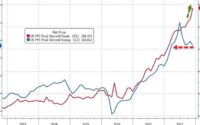The real estate buying frenzy is over


Looks like America’s home buying binge is winding down. There’s a vibe shift visible in both the official data and in the anecdata from sellers, buyers and brokers.
Why it matters: This is just what Jerome Powell ordered. The slowdown means the Fed’s rate hikes are working — cooling demand in an overheated market.
“The buyers just stopped buying,” said Shauna Pendleton, an agent with Redfin in Boise, Idaho, until recently one of the hottest markets in the country. “Californication,” as she called it, drove an influx of buyers from the West coast, flush with cash courtesy of the also formerly booming stock market.
- Some listings now sit for weeks without even a showing, she said; like this 4-bedroom priced at $899,000; 42 days without a look-see.
- In the Dallas/Ft. Worth area, Redfin agent Robin Glaysher said five people showed up to an open house last weekend; previously there would’ve been a line out the door.
- “It’s a completely different market now,” said Glaysher, who works with homes priced around $400,000.
- The change is a boon for some buyers — like those relying on FHA loans that require only 3.5% down, she said. In the old times they were often outbid by cash buyers, who have now vanished.
Driving the news: New home sales plunged in April, falling 16.6% from March to 591,000, well below economists’ forecast of 750,000, according to data out Tuesday. It’s the slowest pace since April 2020 — when the economy froze for a minute before the boom began.
- Existing home sales — perhaps a better measure of the U.S. market since it’s a much larger segment — are also trending down, falling for three straight months, according to the National Association of Realtors.
- Mortgage rates have soared since March and with the 30-year now hovering at around 5.25%, the highest it’s been in years.
- Meanwhile, new housing supply is building. Available inventory of unsold new single family homes jumped by 8% in April to 444,000, a 13-year high.


Catch up quick: The real estate market has been, technically speaking, bananas since COVID, as the rise of remote work — and super-low mortgage rates — sent more people looking to upgrade their living space.
- The surge in demand fueled bidding wars and all kinds of wild activity — buyers waiving inspections or begging sellers to pick them, for example.
- Now, “buyers are less conciliatory, as far as giving whatever we want on the sell side,” said Glaysher, the Texas agent.
What they’re saying: “The party is over,” Ian Shepherdson, chief economist at Pantheon Macroeconomics, wrote in a research note Tuesday.
- “We were going 90 miles an hour down the highway, and we took our foot off the gas,” Michael Simonsen, CEO of Altos, a real estate analytics firm, tells Axios.
- “The market’s shifted from “irrational to more rational,” Jonathan Miller, a New York based real estate appraiser, tells Axios in an email. What used to sell in 24 hours, now could take about a month.
Yes, but: This isn’t 2008. Home prices haven’t started falling. The U.S. median new home price ticked up in April to $450,600 — that’s up 45% from two years ago.
- And though the supply of newly built homes has increased, that’s actually a small part of the overall market. Inventories of existing homes are still some of the lowest on record, as of April.
The bottom line: Though the frenzy is over, “there’s still a lot of pent up demand from people who’ve been shopping for a year,” Simonsen said.
[ad_2]
Source link


